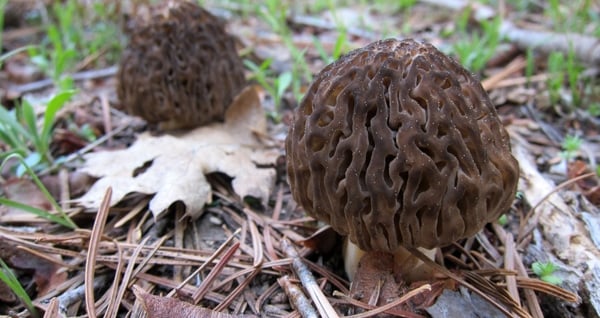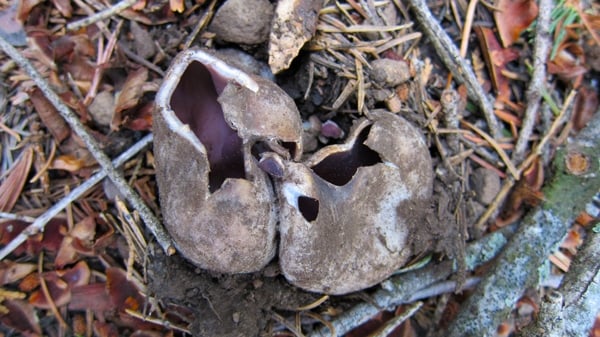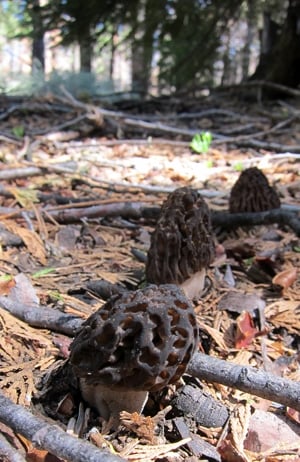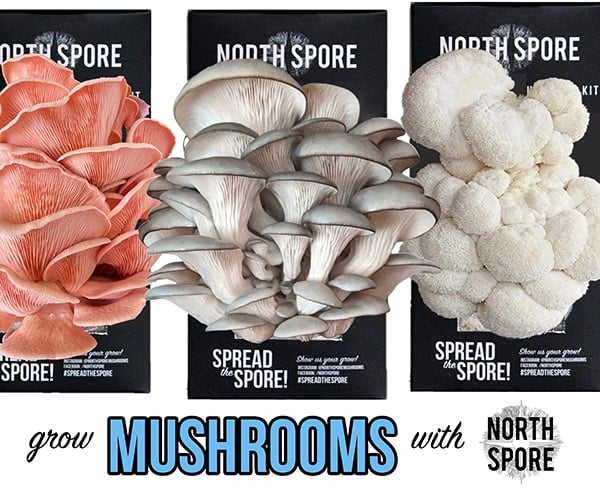As an Amazon Associate I earn from qualifying purchases.

Another day in the blasted, blackened morel woods.
In the East and the Midwest, morel hunting is a pretty affair. The world is green, the air cool and, for the most part, the morels are blonde, making them stand out against the verdant landscape. This is not like hunting morel mushrooms in the West. Here, most of our morels are the bittersweet fruit of the forest fire. Fire causes the morels to fruit in huge numbers. It can be epic.
This year, the Rim Fire near Yosemite is one such place. I’ve heard reports and seen pictures of thousands of morels within one frame of the camera. Unbelievable numbers. A Gold Rush bonanza. But I am not at the Rim Fire. For reasons only they can know, the mandarins who oversee the Stanislaus National Forest have refused to allow mushroomers access to the fire zone; normally we can buy permits to pick in national forests. Word is the rangers are handing out huge fines and are patrolling the area on horseback. It’s a total shitshow, one I want no part of. So I stick to quieter places.
You should know that all burns are not created equal: Some might look good, but produce no morels. Sometimes this is because of elevation — in my experience, burn morels occur mostly above 3000 feet — sometimes it’s the soil, sometimes tree composition (morels out here like conifers), and sometimes it’s a matter of the intensity of the fire and the age of the trees burned. A fierce burn in an older section of forest will be a better place for morels than a controlled burn in a young wood.
Timing is also important. Every morel hunter knows the best mushrooming is in the year after the fire. Some burns peter out the following year. Some are nearly as good in the second year as the first. Most progress something like this: First year after the fire being a 10, the second a 5, the third a 3, the fourth maybe a 1. But not always. I know of one wildfire that’s seven years old and still produces a nice little crop of morels. Why I don’t know, but I suspect it’s because loggers keep chewing up the area, cutting salvage wood and gnashing the soil.
Burn morels are a creature of disturbance. If the forest is a hellscape, you are in the right spot.

Catching the flush is even more important than catching the year. In general, I look for days in the 70s and nights in the 40s, although I’ve seen flushes in the mountains when the daytime temperatures top 85°F. Good indicators of morels are the wild onions that grow all over after a burn: They should be just starting to send up flowers.
The ground will look terrible, but it’s deceiving you. Feel the soil under the matted fir needles. It should be cool and moist. If it’s not, you are too late.
There are two fungal neighbors to morels you should also look for. Both are cup mushrooms. The first is easy to spot: It’s a little orange cup that looks superficially like a piece of tangerine peel; I think this is Aleuria aurantia. The second is mostly buried in the soil, but breaks through as it opens. This is the violet cup fungus, Sarcosphaera coronaria. If you see those two mushrooms, morels should be nearby. Note the emphasis on “should.”

I keep a Google alert for fires in my part of the Sierra. Some are wildfires, some prescribed burns. Once the spring hits, I head up the hill to scout them. I am always too early. Always. Our morel flush isn’t the earliest in the country, so the Southerners and even Midwesterners are getting big numbers by the time our morels show up. It can be frustrating, so I look and walk and look and walk. I think the earliest I’ve yet found morels in the Sierra was Tax Day, but it’s normally the first week of May. I climb up the mountain chasing them as far as there are burns.
It’s a lot of long days in the truck, and on foot. Usually the forest is quiet but for birds. Oregon juncos trilling, chickadees singing “cheese-bur-ger! Cheese-bur-ger!” Flickers and creepers nasally honking to one another. Every once in a while, I’ll hear that subterranean thrum that always startles me. It sounds like its beneath normal human hearing, but you can sense it anyway. Then there’s a furious rush of wings and the blue grouse has rocketed off to the next ridge. Heart-stopping and wondrous all at the same time.
My footfalls crunch and crackle over burnt twigs and matted pine and fir needles. That rush I hear: Is it car? No, just the wind in the pines. I rarely see other humans when I am mushroom hunting, and I do most of my mushrooming solo. It lets me be quiet, for at least a little while.

Hunting morels in a burn isn’t all fun and games. I’ve fallen waist-deep into the burned-out root ball of a ponderosa pine. I’ve turned my ankle, slid down charred hillsides and have had burnt twigs narrowly miss my eyeball. And about once a year, I have a visitor. Usually it’s a black bear just at the edge of the forest, where I can barely see him. Intellectually I know he’s probably not a threat, but after spending countless hours alone in the woods, it’s alarming nonetheless. Twice, however, I’ve felt the hair stand up on the back of my neck and had the feeling I was being watched. I was. Once I saw the lion sprint away, the other time I only heard him. Sobering.
Mostly, however, it’s all a matter of putting in miles. Secondary burns are not bonanza spots. They’re more like regular mushroom hunting in that you might find one here, two there, a patch of 10 under one particularly nice tree. But putting weight in your sack takes time. A good day is a pound, maybe five. A bad day is a whole lotta hiking for nothing.
Actually that’s not true. It’s not nothing. It’s a chance to see up close and personal how a forest resurrects itself. Even after a catastrophic fire, the very next spring life re-emerges. Fir and spruce and pine sprout by the thousands. Manzanita and gooseberry shake off the cinders as if nothing special had happened the previous summer. Wild onions get all the light they need and grow fat by the thousands. Fireweed sends its floral spires three feet into the air, a phoenix after the flames.
And standing above it all are the Lords of the Forest, the great ponderosa and sugar pines that seem impervious to time and fire and snow and ice. These are the mother trees, sometimes soaring 200 feet above me. I kneel at their feet, partly in awe — and partly because I know that under these trees grow morels.





You have to get up early in the morning to find your own morals (too).
Why is your podcast not on iTunes?
Travis: It’ll be back once Season Two returns in a few weeks.
Ever found any in the Ruby Mountains?
Northern California: Some years ago one of my neighbors got a load of madrone firewood. Many of the pieces were slightly scorched. Obviously the wood had been gathered in a burned area. The firewood sat all winter covered by a tarp. The next spring a couple of dozen black morels grew from the ground under the firewood. I suppose that the firewood had carried morel spores from a post-fire morel bloom.
I just picked a pound of morels in our Santa Rosa backyard, Our neighborhood backed up to a burn area in Annadel State PArk. I wonder if morel spores carried in the smoke landed in our yard and found a happy place to fruit Anyway, back out to pull weeds and hopefully find more!
I love how you describe things I always see and hear up there. I hear the chickadee saying “hey bud dy” “hey bud dy” Thanks for the shroomin advice.
Hi Hank,
Has morel fever struck you yet? All we need is a few dozen feet of snow to melt and maybe our paths will cross, somewhere in the Sierra!
Good article, but one correction: your bright orange morel indicator cups are not Aleuria aurantia, the orange peel fungus, but the snowmelt species Caloscypha fulgens, one that often has green shades to its cup. Not edible, of course, but way easier to see than our true quarry, those all too cryptic morels!
And although nobody likes to get skunked on a morel hunt, I must disagree on just one more point … even without finding morels, there is no such thing as a “bad day” in a spectacular spring Sierran forest!
Mushrooms are just one part of that amazing biological tapestry of life, as you so beautifully describe here.
Best,
Debbie Viess
Bay Area Mycological Society
Great article! We, my husband an I pick/hunt Morels every spring in Almanor. We camp in between Lassen and Almanor. It’s hit and miss what years are better than others. But we will always go no matter what & no matter if it’s snowing or not!
Leah- I just got back from my first trip to Iowa and learned about hunting morels! I’m hooked now.
I just moved back from Iowa to Nevada. We used to go morel hunting along the Missouri River, nothing to find several grocery bags full. One year we found 12 pounds in one trip. My favorite way to eat them was stuff with cream cheese and beer batter dip deep fry them. I have not found anyone out here that actually hunts them or anyone that knows where to go. Gosh, I miss Iowa morels.
I noticed you made mention of disturbed earth, some of the best flushes of blacks can be found in these areas in Ca, and don’t forget to buy your mushroom permit either!
How old does a burn have to be for morels to grow? Does it have to be from just last year, or can it be several years old? What is the limit?
Found the first crop of the year today coming out of the sand on the sunny side of a trail. It’s about two weeks early for our area of Alaska. The funny part was going 50 feet past them on an ATV while the morel fairy was screaming stop. My brain finally engaged and slammed on the brakes. Once the search image was imprinted for this year I quickly found a hat full. Wallowing in post-morel bliss now. My vote is to not sully your morels with flour and cook them in a little butter and bacon grease halved vertically until just tender.
Hey Hank,
Nice article on both the magic and insanity of this years post-fire morel season here in California! Although the Rim fire and its juxtaposition of mind-blowing morel abundance (true), coupled with overly restrictive, bordering on punitive, forest service regulations in the Stanislaus National Forest, as well as restricted access for picking any mushrooms in Yosemite itself, makes for some rather frustrated California mushroom hunters.
But all is not lost. There are plenty of other spots in California producing morels, just not carpets of them. But where is the hunting challenge in THAT??!
BTW, the orange cup fungus that is one of the Sierran morel indicator species is not Aleuria aurantia but the greenish tinged Caloscypha fulgens.
Other than that small error, fine piece of writing. Next best thing to being there in those regenerating woods!
Debbie Viess
Bay Area Mycological Society
http://www.bayareamushrooms.org
Your blog entry today was so timely. My spouse and I spent the early afternoon in the woods NE of Madison, WI, foraging for the mighty Morel. We came up empty but came upon newborn fawn just hours old. It was breath-taking as we watched her curled up tight and very still. It was a spectacular moment!
In Michigan some of us hunt the elusive, but tasty blacks. They usually appear in April (not so this year). They look like the pictures you posted but now nestle them in 3″-6″ of leaves barely poking through. It’s early, only the lime green sheen of leaves just beginning to show. The myrtle, bleeding hearts, Jack-in-the-pulpit and Ramps are just starting to appear. We are battling Spring rains, sometimes snow squalls and cool Spring winds.
It’s a time of re-birth the Sandhill cranes and Canada geese are pausing on their migrations. The robins are back and you can see forever through the great Midwestern forest as magical as any Tropical Rain-forest or Pacific Northwest forest.
You walk for miles trying to get you eyes accustomed to the elusive Morel. And then your heart almost jumps out of your chest when you find the first one. You stop in amazement just to savor that first find. But wait there’s another, 3′ away and you turn around to see the couple you walked past. Is it “the find” …no just a handful.
But now you have the fever, again, so with your heart lightened you walk on. If there is a few there must be more. At the end of a good day you have enough for a pan maybe two. But the real reward is you have walked the woods, reminisced on past hunts, you spiritually revitalized your spirit and your body and you know that while Babylon may control you for 40 or so hours a week you are FREE and will never be conquered.
Stardust…the Mother, the one legged, the two legged,the four legged those that crawl and those that fly…we are all one and life is GOOD.
Thanks for breaking the morel mushroom mystery for me. My dad & I have always hunted for them and read about them in western identification books but none mention the post fire aspect of their growth. We just figured in our fruitless search that we were looking at the wrong elevations or not quite the right time of year or even possibly the year was not wet enough. But now I can see our searches were more of a “trial by fire” as now I understand the key to morel hunting success. Thanks.
I live just outside the Rim Fire area. 5 gallon buckets of them are common right now. So too the $150.00 fine (starts there), and the confiscation of all mushrooms in possession. Of course they can take your vehicle if the mood strikes them. Just setting foot in the designated fire area can result in fines and arrest. I’ll stick to my B. edulis for now…
Must hear more. Is it a west thing for the morels to burst after a burn? I’ve been working on a bit of writing about California fire for a few years now, and thought my research is shoddy at best, I’ve never heard about morels. Is this common knowledge? And may I applaud your ending?!
I spent some time in Iowa and met a friend who swore he found them by smell. He would just follow his nose. I was skeptical but couldn’t argue with the results. He would dredge them in milk and cracker crumbs and pan fry them in a bit of butter. It was my first experience with morels. I’ve been a lonely addict ever since. Lonely because here in So. Cal. morel hunting is a short season between cold&dry and hot&dry.
Sometimes I envy those who can forage such delicacies as ramps and morels so close to their home. Other times I’m just jealous. Thanks for rubbing it in, Hank. 🙂